The MSI Prestige 14 Evo Review: Testing The Waters Of Tiger Lake
by Brett Howse on December 17, 2020 10:00 AM EST- Posted in
- Laptops
- Intel
- MSI
- Tiger Lake
- Notebook
Battery Life
Always an important aspect to any thin and light laptop is battery life, and we’ve seen a trend over the last several years slightly reverse, as Ultrabooks started to pack in larger and larger batteries to increase battery life. 50 Wh batteries were pretty typical, but manufacturers managed to cram in more, with some devices offering 60 Wh or more. But more battery is more cost and more weight, so with more efficient displays, processors, and other components, manufacturers have been moving back down and it seems like around 50 Wh is again the average for this current generation. MSI fits in here with a 52 Wh capacity battery in their 14-inch laptop.
To measure battery life, we test all laptops at the same screen brightness of 200 nits, and then run them through three tests. Our most demanding test is our web one. We’ve recently added the PCMark 10 battery life test as well for Modern Office. This one also adds in a performance element though as it completes a fixed amount of work in a ten-minute interval. Any device that can complete the work quicker is able to idle for a higher percentage of the time. Finally, we have movie playback from the hard drive, which is the easiest test for any modern system.
Web Battery
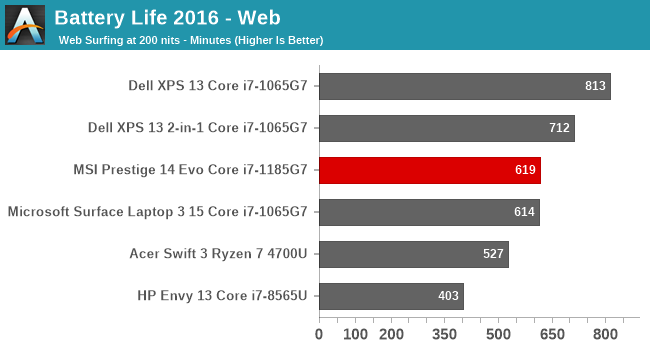
MSI delivers excellent battery life in our most demanding test. The device is not quite at the top, but over ten hours is a solid result in this quite demanding workload. Intel’s Evo platform makes a good first impression.
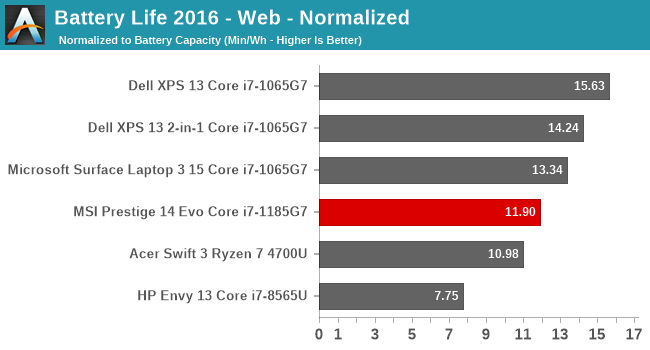
Looking at the normalized results, where battery size is removed from the equation, the efficiency is very solid especially considering the display size. It is not class leading, but it is still a good result.
PCMark 10 Modern Office
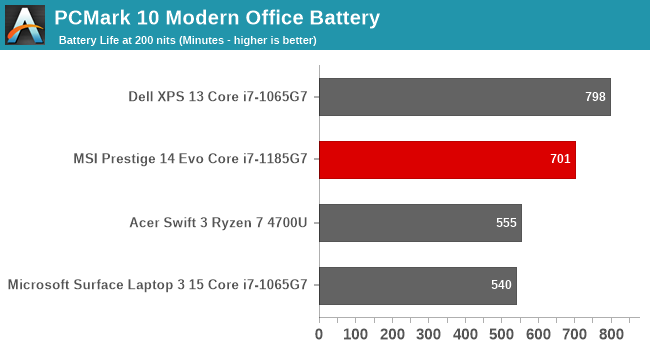
The PCMark 10 result at 200 nits is over 80 minutes longer than the web workload, and the runtime of over 700 minutes is the second highest we’ve seen since we added this test to the suite. Tiger Lake appears to be able to get its work done quickly and then drop down to a very efficient idle.
Movie Playback
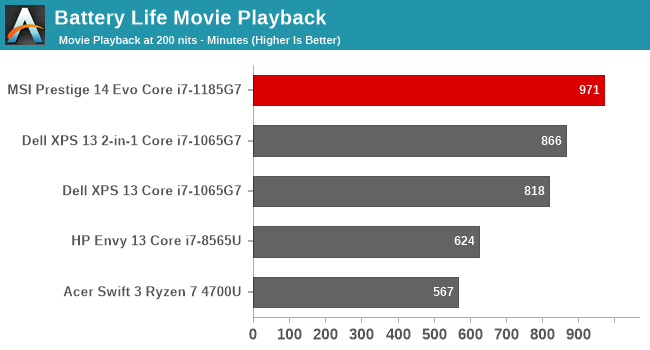
Modern processors are able to offload video decode to fixed-function hardware in the GPU, and Intel’s media block has proven to be very efficient in the past, so it should not be a surprise to see that the new Intel Xe media block continues to deliver exceptional efficiency.
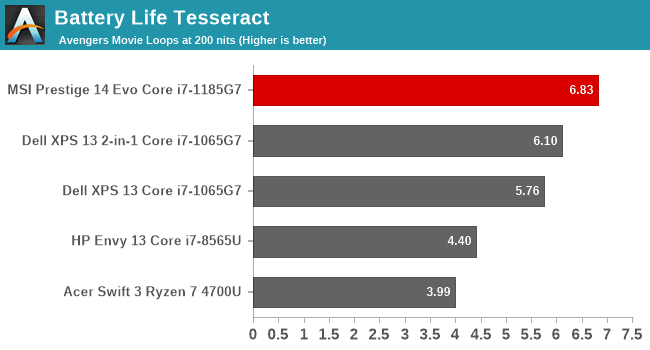
Looking at the movie playback in terms of how many long movies can I watch on this laptop shows that the MSI Prestige should be able to easily get through almost any long flight or road trip without recharging needed. You can almost watch The Avengers seven times straight before the device powers off.
Charge Time
Part of the Intel Evo specifications is not just battery life and performance, but also charge time, with devices needing to be able to deliver four hours of runtime on just 30 minutes of charging. MSI includes a multi-voltage adapter which peaks at 65 watts delivery at 20 volts, which charges over the Type-C ports on the notebook. Let’s see how it fares.
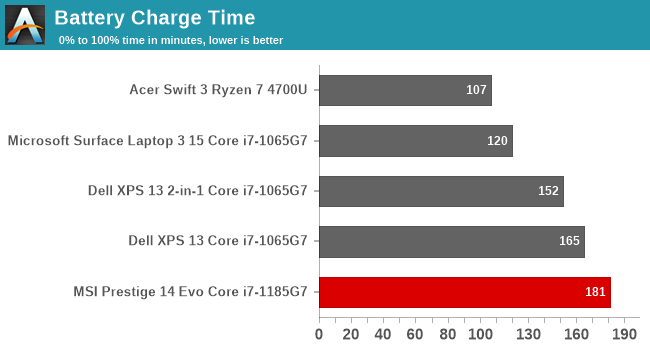
The total charge time is not very special, with the laptop needing about three hours to completely charge, but that includes the notebook sitting at 98% charge for an entire hour. It is not surprising to see the charge rate slow dramatically as the device gets close to being full, but an entire hour to finish the last two percent is a very long wait. Those that do need a quick top up though will find that the lower half of the battery does charge very quickly, with the laptop hitting 50% in just 34 minutes. Depending on your workload, that means the device definitely meets its Intel Evo ratings.











63 Comments
View All Comments
Vitor - Thursday, December 17, 2020 - link
Im just glad the display has decent accuracy.Teckk - Thursday, December 17, 2020 - link
This is a really good enough laptop for a lot of people and surprisingly good graphics performance by Intel. Is 1 Watt display not a requirement for Evo?gizmo23 - Thursday, December 17, 2020 - link
This laptop with 16:10 ratio display = take my money. As it is, I think my XPS will have to last a bit longer.s.yu - Friday, December 18, 2020 - link
My 2019 XPS132N1's digitizer experience really sucks, but I looked around the market and nothing really serves as a solid upgrade. If the latest Surface Book weren't so expensive with soon to be outdated graphics that would be my first choice.oRAirwolf - Saturday, December 19, 2020 - link
Offering a laptop with a 16x9 display when it's almost 2021 is pretty well. Get with the times MSI. 16x9 is fine on a large display, but laptops greatly benefit from some extra vertical real estatemobutu - Thursday, December 17, 2020 - link
almost bought this, luckily that I saw at the last time that, at the begining of 2021, it doesn't have at least one USB 3.x.A port ... good thing it has a TOTALLY USELESS 2.0.A one.I would torture the guys at msi for this stupid decision. what a bunch of retards .
ozzuneoj86 - Thursday, December 17, 2020 - link
I am totally confused by this decision as well. What a complete waste of a computer. What are you supposed to do with external storage devices that connect with USB A? Carry around adapters, or just deal with USB 2.0 speeds? In 2021!?!?And as a general complaint with most "nice" laptops these days, what if you use a mouse that connects via USB??? No flash drives then?
Might as well be an Apple product.
And no, it isn't a typo. The MSI site shows this across the board for all configurations of this model "USB: 1x USB 2.0"
Yakinabe - Thursday, December 17, 2020 - link
The USB 2.0 port is for your mouse. That's why it's on the right side. For faster peripherals like storage devices, it has two Thunderbolt ports. If you insist on keeping your legacy storage devices then yeah, you'd need to get a USB-C cable for your device, or carry an adapter.CharonPDX - Thursday, December 17, 2020 - link
Or use one of my dozens of USB-A 3.0 64-256 GB thumb drives. Or my external Blu-ray drive that has a tethered cable.Modern EFI and OSes can handle running a keyboard or mouse just fine over USB 3.0/3.1/3.2/4. There is no reason to continue to offer a USB 2.0 USB port.
The_Assimilator - Thursday, December 17, 2020 - link
While I agree that the choice of USB 2.0 is bizarre, my guess is that it's due to SOC peripheral bandwidth limitations - those two TB4 ports consume a LOT of PCIe lanes, and IIRC Tiger Lake has a relatively low PCIe lane count due to thermal and power constraints.